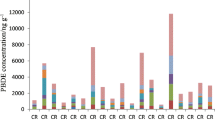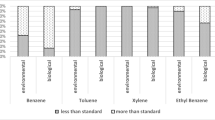Abstract
Indoor air quality is an increasing concern; it causes significant damage to health because it is recycled in confined environments for extended periods of time. Among the pollutants found in these environments, benzene, toluene, ethylbenzene, and xylenes (BTEX) are known for their potential toxic, mutagenic, and carcinogenic effects. This study monitored the BTEX concentrations in paint, carpentry, and varnish workplaces and evaluated the potential to cause adverse health effects on workers in these environments. Twenty samples were collected in workplaces, 20 samples were collected outside the area, and eight samples were taken of the products used. Samples were collected using coconut shell cartridges, and chemical analyses were performed by gas chromatography with mass spectrometry. Toluene presented higher indoor concentrations and indoor and outdoor ratios, indicating that the paint and varnish workplaces had significant BTEX sources. The highest benzene and toluene concentrations were obtained from the paint workshop, and higher concentrations of ethylbenzene and xylenes were obtained in the varnish workshop. The highest non-carcinogenic risks were obtained for m + p-xylenes in the varnish work place, and the second highest non-carcinogenic risk was also determined for the same workshop.

Similar content being viewed by others
References
ACGIH. (2008). Threshold limit value and biological exposure. American Conference of Governmental Industrial Hygienists: USA.
Bravo, H., Sosa, R., Sánchez, P., Bueno, E., & González, R. (2002). Concentrations of benzene and toluene in the atmosphere of the southwestern area at the Mexico City Metropolitan Zone. Atmospheric Environment, 36, 3843–3849. doi:10.1016/S1352-2310(02)00292-3.
Chan, C. Y., Chan, L. Y., Wang, X. M., Liu, Y. M., Lee, S. C., Zou, S. C., Sheng, G. Y., & Fu, J. M. (2002). Volatile organic compounds in roadside microenvironments of metropolitan Hong Kong. Atmospheric Environment, 36, 2039–2047. doi:10.1016/S1352-2310(02)00097-3.
Corrêa, S. M., & Arbilla, G. (2007). A two-year of aromatic hydrocarbons monitoring at the downtown area of the city of Rio de Janeiro. Journal of the Brazilian Chemical Society, 18, 539–543. doi:10.1590/S0103-50532007000300007.
Corrêa, S. M., Arbilla, G., Marques, M. R. C., & Oliveira, K. M. P. G. (2012a). The impact of BTEX emissions from gas stations into the atmosphere. Atmospheric Pollution Research, 3, 163–169. doi:10.5094/APR.2012.016.
Corrêa, S. M., Souza, C. V., Sodré, E. D., & Teixeira, J. R. (2012b). Volatile organic compound emissions from a landfill, plume dispersion and the tropospheric ozone modeling. Journal of the Brazilian Chemical Society, 23, 496–504. doi:10.1590/S0103-50532012000300017.
de Castro, B. P., Machado, G. S., Bauerfeldt, G. F., Fortes, J. D. N., & Martins, E. M. (2015). Assessment of the BTEX concentrations and reactivity in a confined parking area in Rio de Janeiro, Brazil. Atmospheric Environment, 104, 22–26. doi:10.1016/j.atmosenv.2015.01.013.
Dewangan, S., Chakrabarty, R., Zielinska, B., & Pervez, S. (2013). Emission of volatile organic compounds from religious and ritual activities in India. Environmental Monitoring and Assessment, 185, 9279–9286. doi:10.1007/s10661-013-3250-z.
Durmusoglu, E., Taspinar, F., & Karademir, A. (2010). Health risk assessment of BTEX emissions in the landfill environment. Journal of Hazardous Materials, 176, 870–877. doi:10.1016/j.jhazmat.2009.11.117.
Dutta, C., Som, D., Chatterjee, A., Mukherjee, A. K., Jana, T. K., & Sen, S. (2009). Mixing ratios of carbonyls and BTEX in ambient air of Kolkata, India and their associated health risk. Environmental Monitoring and Assessment, 148, 97–107. doi:10.1007/s10661-007-0142-0.
Farshad, A., Oliaei, H. K., Mirkazemi, R., & Bakand, S. (2013). Risk assessment of benzene, toluene, ethylbenzene and xylenes (BTEX) in paint plants of two automotive industries in Iran by using the COSHH guideline. European Science Journal, 3, 270–276.
Gioda, A., & Aquino Neto, F. R. (2003). Comments on studies of industrial and non-industrial environments in Brazil: a comparative approach. Cadernos de Saúde Pública, 19, 1389–1397.
Guo, H., Murray, F., & Wilkinson, S. (2000). Evaluation of total volatile organic compound emissions from adhesives based on chamber tests. Journal of the Air & Waste Management Association, 50, 199–206. doi:10.1080/10473289.2000.10464006.
Guo, H., Lee, S. C., Chan, L. Y., & Li, W. M. (2004). Risk assessment of exposure to volatile organic compounds in different indoor environments. Environmental Research, 94, 57–66. doi:10.1016/S0013-9351(03)00035-5.
Hinwood, A. L., Rodriguez, C., Runnion, T., Farrar, D., Murray, F., Horton, A., & Galbally, I. (2007). Risk factors for increased BTEX exposure in four Australian cities. Chemosphere, 66, 533–541. doi:10.1016/j.chemosphere.2006.05.040.
Ilgen, E., Karfich, N., Levsen, K., Angerer, J., Schneider, P., Heinrich, J., Wichmann, H., Dunemann, L., & Begerow, J. (2001). Aromatic hydrocarbons in the atmospheric environment: part I. Indoor versus outdoor sources, the influence of traffic. Atmospheric Environment, 35, 1235–1252. doi:10.1016/S1352-2310(00)00388-5.
Jones, A. P. (1999). Indoor air quality and health. Atmospheric Environment, 33, 4535–4564. doi:10.1016/S1352-2310(99)00272-1.
Jung, K. H., Artigas, F., & Shin, J. Y. (2010). Personal, indoor, and outdoor exposure to VOCs in the immediate vicinity of a local airport. Environ Monit Assess, 173, 555–567. doi:10.1007/s10661-010-1404-9.
Karakitsios, S. P., Sarigiannis, D. A., Gotti, A., Kassomenos, P. A., & Pilidis, G. A. (2013). A methodological frame for assessing benzene induced leukemia risk mitigation due to policy measures. Science of the Total Environment, 443, 549–558.
Klinmalee, A., Srimongkol, K., & Kim Oanh, N. T. (2009). Indoor air pollution levels in public buildings in Thailand and exposure assessment. Environmental Monitoring and Assessment, 156, 581–594. doi:10.1007/s10661-008-0507-z.
Kumar, A., Singh, B. P., Punia, M., Singh, D., Kumar, K., & Jain, V. K. (2014). Assessment of indoor air concentrations of VOCs and their associated health risks in the library of Jawaharlal Nehru University, New Delhi. Environmental Science and Pollution Research International, 21, 2240–2248. doi:10.1007/s11356-013-2150-7.
LaGrega, M. D., Buckingham, P. L., & Evans, J. C. (1994). Hazardous waste management. New York: McGraw Hill. ISBN 0-07-019552-8.
Lim, S. K., Shin, H. S., Yoon, K. S., Kwack, S. J., Um, Y. M., Hyeon, J. H., Lee, B. M., et al. (2014). Risk assessment of volatile organic compounds benzene, toluene, ethylbenzene, and xylene (BTEX) in consumer products. Journal of Toxicology and Environmental Health A, 77, 1502–1521. doi:10.1080/15287394.2014.955905.
Maroni, M., Seifert, B., & Lindvall, T. (1995). Indoor air quality—a comprehensive reference book. Amsterdam: Elsevier. ISBN 0444816429.
Martins, E. M., Quiterio, S. L., Corrêa, S. M., Fortes, J. D. N., Monteiro, M., & Prestes, B. (2014). BTEX inside a spinning classroom. Cadernos de Saúde Coletiva, 22, 218–220. doi:10.1590/1414-462X201400020017.
Massolo, L., Rehwagen, M., Porta, A., Ronco, A., Herbarth, O., & Mueller, A. (2010). Indoor-outdoor distribution and risk assessment of volatile organic compounds in the atmosphere of industrial and urban areas. Environmental Toxicology, 25, 339–349. doi:10.1002/tox.20504.
Ministry of Labor and Employment (MTE) (1994) Regulatory Standard (NR 9). Prevention program of environmental risks. http://sislex.previdencia.gov.br/paginas/05/mtb/9.htm. Accessed 28 May 2015.
Ministry of Labor and Employment (MTE) (1995a) Normative Instruction N. 1. Assessment of benzene concentrations in workplaces relating to Annex 13-A Benzene, of Regulatory Standard n. 15—unhealthy activities and operations. http://www.lex.com.br/doc_10174_INSTRUCAO_NORMATIVA_N_1_DE_20_DE_DEZEMBRO_DE_1995.aspx. Accessed 08 Jul 2015.
Ministry of Labor and Employment (MTE) (1995b) Ordinance no. 14. Change the item of carcinogenic substances of Annex 13, of Regulatory Standard no. 15—unhealthy activities and operations. http://sislex.previdencia.gov.br/paginas/05/mtb/15.htm. Accessed Jul 2015.
NIOSH. (2003). Manual of analytical methods (NMAM) (4th ed.). National Institute for Occupational Safety and Health, Accessed 28 May 2015.
OSHA. (2016). Occupational Safety and Health Administration. https://www.osha.gov/dsg/annotatedpels/tablez-1.html. Accessed Oct 2016.
Palmiotto, M., Fattore, E., Paiano, V., Celeste, G., Colombo, A., & Davoli, E. (2014). Influence of a municipal solid waste landfill in the surrounding environment: toxicological risk and odor nuisance effects. Environmental International, 68, 16–24. doi:10.1016/j.envint.2014.03.004.
Possanzini, M., Di Palo, V., & Cecinato, A. (2002). Sources and photodecomposition of formaldehyde and acetaldehyde in Rome ambient air. Atmospheric Environment, 36, 3195–3201. doi:10.1016/S1352-2310(02)00192-9.
Ras, M. R., Marcé, R. M., & Borrull, F. (2010). Volatile organic compounds in air at urban and industrial areas in the Tarragona region by thermal desorption and gas chromatography-mass spectrometry. Environmental Monitoring and Assessment, 161, 389–402. doi:10.1007/s10661-009-0755-6.
Rodrics, J. V., Brett, S. M., & Wrenn, G. C. (1987). Significant risk decisions in federal regulatory agencies. Regulatory Toxicology and Pharmacology, 7, 307–320. doi:10.1016/0273-2300(87)90038-9.
Rodrigues, F., Milas, I., Martins, E. M., Arbilla, G., Bauerfeldt, G. F., & Paula, M. D. (2007). Experimental and theorical study of the air quality in a suburban industrial-residential area in Rio de Janeiro, Brazil. Journal of the Brazilian Chemical Society, 18, 342–351. doi:10.1590/S0103-50532007000200015.
Sarigiannis, D. A., & Gotti, A. (2008). Biology-based dose-response models for health risk assessment of chemical mixtures. Fresenius Environmental Bulletin, 17, 1439–1451.
Sarigiannis, D., Gotti, A., Cimino Reale, G., & Marafante, E. (2009). Reflections on new directions for risk assessment of environmental chemical mixtures. International Journal of Risk Assessment and Management, 13, 216–241.
Sarigiannis, D. A., Karakitsios, S. P., Gotti, A., Liakos, I. L., & Katsoyiannis, A. (2011). Exposure to major volatile organic compounds and carbonyls in European indoor environments and associated health risk. Environmental International, 37, 743–765. doi:10.1016/j.envint.2011.01.005.
Tunsaringkarn, T., Siriwong, W., Rungsiyothin, A., & Nopparatbundit, S. (2012). Occupational exposure of gasoline station workers to BTEX compounds in Bangkok, Thailand. International Journal of Occupational Environmental Medicine, 3, 117–125.
U.S.EPA (1989) Risk assessment guidance for superfund. Volume I—human health evaluation manual (part A) EPA/540/1-89/002. Washington D.C. 20450.
Vilavert, L., Nadal, M., Figueras, M. J., & Domingo, J. L. (2012). Volatile organic compounds and bioaerosols in the vicinity of a municipal waste organic fraction treatment plant. Human health risks. Environmental Science Pollution Research, 19, 96–104. doi:10.1007/s11356-011-0547-8.
Ward, T. J., Underberg, H., Jones, D., Hamilton, R. F., & Adams, E. (2009). Indoor/ambient residential air toxics results in rural western Montana. Environmental Monitoring and Assessment, 153, 119–126. doi:10.1007/s10661-008-0342-2.
Weisel, C. P. (2010). Benzene exposure: an overview of monitoring methods and their findings. Chemico-Biological Interactions, 184, 58–66. doi:10.1016/j.cbi.2009.12.030.
Wilbur, S., Wohlers, D., Paikoff, S., Keith, L. S., & Faroon, O. (2008). ATSDR evaluation of health effects of benzene and relevance to public health. Toxicology Industrial Health, 24, 263–398. doi:10.1177/0748233708090910.
Yoon, C., Lee, K., & Park, D. (2011). Indoor air quality differences between urban and rural preschools in Korea. Environmental Science and Pollution Research, 18, 333–345. doi:10.1007/s11356-010-0377-0.
Acknowledgments
The authors wish to thank the Research Support Foundation of the State of Rio de Janeiro (FAPERJ) and National Council for Scientific and Technological Development (CNPq) for the financial support and research grants.
Author information
Authors and Affiliations
Corresponding author
Rights and permissions
About this article
Cite this article
Martins, E.M., Borba, P.F.d.S., dos Santos, N.E. et al. The relationship between solvent use and BTEX concentrations in occupational environments. Environ Monit Assess 188, 608 (2016). https://doi.org/10.1007/s10661-016-5621-8
Received:
Accepted:
Published:
DOI: https://doi.org/10.1007/s10661-016-5621-8




